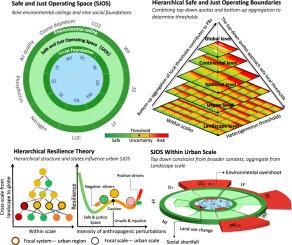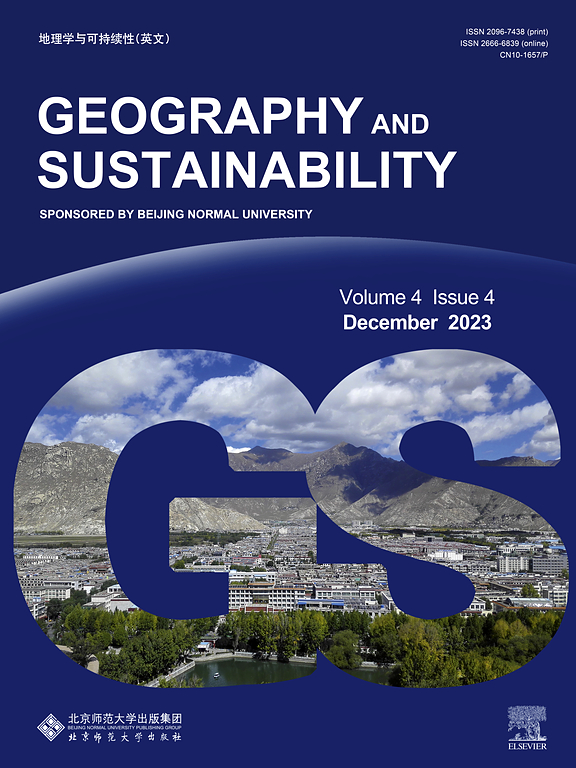为城市系统导航安全和公正的操作空间:一种跨尺度的景观方法
IF 8
1区 环境科学与生态学
Q1 GEOGRAPHY, PHYSICAL
引用次数: 0
摘要
安全与公正的操作空间(SJOS)受到复杂的跨尺度相互作用和级联效应的影响,这些效应跨越全球、区域和地方景观尺度。然而,现有的城市sjo研究往往侧重于单尺度评估,忽视了多尺度相互作用和区域内异质性对城市sjo的影响。为了解决这一差距,我们开发了一个评估城市sjo的跨尺度框架,明确地结合了上层约束的自上而下影响和下层异质性的自下而上影响。以1990 - 2020年中国五大城市为例,研究了影响城市sjo的状态和跨尺度动态。研究结果表明,中国大都市的sjo主要受国家和地方景观尺度的影响,全球和大陆尺度的影响较弱。社会公正与环境安全之间的持续权衡跨越时空尺度。例如,中国西南部的重庆在社会绩效方面落后于东部四大大都市,但由于其广泛的自然景观,减轻了城市中心的人为影响,因此表现出更强的环境安全性。区域问题,如PM2.5和生态足迹(EF)的超调,主要是由局部压力的自下而上积累驱动的,而CO 2的超调则归因于国家政策约束和跨尺度的普遍超过安全阈值。解决城市可持续性问题需要通过强调大都市内部景观的异质性和促进跨尺度(特别是区域景观和国家层面)的协调合作,避免来自其他层面的负面级联效应。本文章由计算机程序翻译,如有差异,请以英文原文为准。

Navigating the safe and just operating space for urban systems: A cross-scale landscape approach
Safe and just operating spaces (SJOS) are influenced by complex cross-scale interactions and cascading effects spanning global, regional, and local landscape scales. However, existing SJOS research has often focused on single-scale assessments, overlooking the impacts of multiscale interactions and within-region heterogeneity on urban SJOS. To address this gap, we developed a cross-scale framework for assessing urban SJOS, explicitly incorporating top-down influences from upper-level constraints and bottom-up effects from lower-level heterogeneity. This approach was applied to China’s five major metropolises to examine the states and cross-scale dynamics influencing urban SJOS between 1990 and 2020. Our findings reveal that the SJOS of China’s metropolises were primarily influenced by factors at national and local landscape scales, with weaker influences from the global and continental scales. A persistent trade-off between social justice and environmental safety was identified across spatiotemporal scales. For instance, Chongqing in southwestern China lagged behind the eastern four metropolises in social performance but exhibited stronger environmental safety due to its extensive natural landscapes, which mitigated the anthropogenic impacts of urban centers. Regional issues, such as the overshoot of PM2.5 and ecological footprints (EF), were primarily driven by the bottom-up accumulation of localized pressures, while the overshoot of CO₂ was attributed to national policy constraints and the universal exceedance of safe thresholds across scales. Addressing urban sustainability requires avoiding adverse cascading effects from other levels by emphasizing landscape heterogeneity within metropolises and fostering coordinated collaboration across scales, particularly at the regional landscape and national levels.
求助全文
通过发布文献求助,成功后即可免费获取论文全文。
去求助
来源期刊

Geography and Sustainability
Social Sciences-Geography, Planning and Development
CiteScore
16.70
自引率
3.10%
发文量
32
审稿时长
41 days
期刊介绍:
Geography and Sustainability serves as a central hub for interdisciplinary research and education aimed at promoting sustainable development from an integrated geography perspective. By bridging natural and human sciences, the journal fosters broader analysis and innovative thinking on global and regional sustainability issues.
Geography and Sustainability welcomes original, high-quality research articles, review articles, short communications, technical comments, perspective articles and editorials on the following themes:
Geographical Processes: Interactions with and between water, soil, atmosphere and the biosphere and their spatio-temporal variations;
Human-Environmental Systems: Interactions between humans and the environment, resilience of socio-ecological systems and vulnerability;
Ecosystem Services and Human Wellbeing: Ecosystem structure, processes, services and their linkages with human wellbeing;
Sustainable Development: Theory, practice and critical challenges in sustainable development.
 求助内容:
求助内容: 应助结果提醒方式:
应助结果提醒方式:


